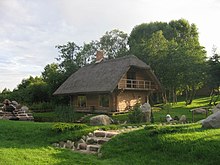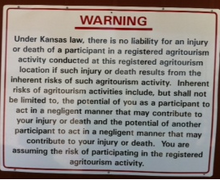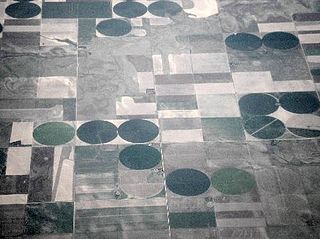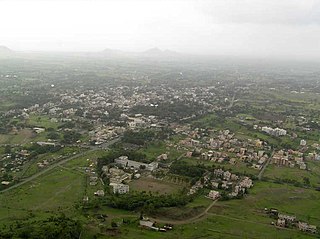| Rural Society |
|---|




Agritourism or agrotourism involves any agriculturally based operation or activity that brings visitors to a farm or ranch.
| Rural Society |
|---|




Agritourism or agrotourism involves any agriculturally based operation or activity that brings visitors to a farm or ranch.
A 2018 article published in the Journal of Agriculture, Food Systems, and Community Development classified agritourism activities as falling into one or more categories: direct-to-consumer sales (e.g., farm stands, u-pick), agricultural education (e.g., schools visits to a farm), hospitality (overnight farm stays), recreation (e.g., hunting, horseback riding), and entertainment (e.g., hayrides, harvest dinners). [1] Most agritourists spent time visiting farm stands, picking fruit, or feeding animals; others may navigate a corn maze or do a farm stay, assisting with chores or agricultural or ranch work. [2]
Agricultural tourism has become a necessary means for many small farms’ survival. By diversifying business operations, farm operators are able to ensure a more stable income. This is because agritourism activities can occur during times of the year that crops may not be in season, and by providing a completely separate stream of income. [3] Some studies have found that agritourism operations often benefit their surrounding communities by drawing tourists to the area. The economic boost by the increase in traffic can be beneficial to rural areas in need of diversified streams of income. [4]

Since 1985 agritourism in Italy is formally regulated by a state law, [5] amended in 2006. [6]
Starting in 2013 Italy has used a sector trademark, “Agriturismo Italia”, [7] accompanied by a new system of classification of farms with accommodation.
The trademark, which distinguishes farms regularly operating in accordance with existing laws and regulations, shows a sunflower enclosing a farm.
The classification (from 1 to 5 marks) represents the level of comfort, the variety of services and the quality of the natural environment that each farm is able to offer.
This system was implemented by the Ministry of Agriculture, [8] in cooperation with all regional and national agritourism associations.
The national system thus offers an overall guarantee which still takes account of specific regional characteristics.
Through the Small Farm Center at the University of California, "Agricultural tourism or agritourism, is one alternative for improving the incomes and potential economic viability of small farms and rural communities. Some forms of agritourism enterprises are well developed in California, including fairs and festivals. Other possibilities still offer potential for development". [9] The UC Small Farm Center has developed a California Agritourism Database that "provides visitors and potential entrepreneurs with information about existing agritourism locations throughout the state". [10] An example of agritourism in the U.S. may be Tanaka Farms.
According to a 2011 article in the journal Tourism Planning and Development, agritourism has become economically important to the agriculture sector in North West England, as farmers seek to diversify their income streams. [11]
The development of agritourism was of high importance in the process of revitalization of rural life in Armenia. Apart from participation in agricultural activities and farming, some more notable activities specific to Armenia are winemaking and carpet weaving. [12]
There are also agricultural festivals and farmer's fairs organized every year, like the "Dolma" festival, "Barbeque (Khorovats)" festival, "Gata" festival, and many more. [12]
85% of India's population is directly or indirectly dependent on agriculture and allied activities. [13] Similarly, agriculture accounts for 26% of India's GDP. [13] Maharashtra and Kerala are the states in India that are taking advantage of the potential of agritourism. In Maharashtra Agritourism is promoted by the Agri Tourism Development Corporation. [14] Kuttanad, Wayanad, Palakkad and Idukki are some of the important agricultural areas in Kerala. The 'Green Farm' project launched by the Government of Kerala is aimed at promoting agro-tourism in Kerala. [15] Apart from Kerala and Maharashtra, Nagaland and Sikkim are also successful agri-tourism states. [16]
Pakistan is an agricultural country and agriculture is a vital sector of Pakistan's economy. About 65% of people live in rural areas and directly or indirectly relate to profession of agriculture. Agriculture in Pakistan accounts 21% of total GDP in the economy. Pakistan has natural resources for agriculture, like fertile land, four seasons, and a natural flow of water canals from north to south, including dams, barrages, headwork, canals, and distribution channels.
UAE unveiled a pioneering plan in 2023, aimed at revamping the agricultural industry, opening up an array of opportunities for farmers to diversify their income streams to promote agritourism. [17] The 'UAE Agritourism Program' allows people to experience conventional and modern agricultural practices at animal and crop farms, whilst aiming to increase the demand for locally grown produce. [18] A new agritourism hub is also expected to create thousands of new jobs. [19]

A farm is an area of land that is devoted primarily to agricultural processes with the primary objective of producing food and other crops; it is the basic facility in food production. The name is used for specialized units such as arable farms, vegetable farms, fruit farms, dairy, pig and poultry farms, and land used for the production of natural fiber, biofuel, and other commodities. It includes ranches, feedlots, orchards, plantations and estates, smallholdings, and hobby farms, and includes the farmhouse and agricultural buildings as well as the land. In modern times, the term has been extended so as to include such industrial operations as wind farms and fish farms, both of which can operate on land or at sea.

In general, a rural area or a countryside is a geographic area that is located outside towns and cities. Typical rural areas have a low population density and small settlements. Agricultural areas and areas with forestry are typically described as rural, as well as other areas lacking substantial development. Different countries have varying definitions of rural for statistical and administrative purposes.

Subsistence agriculture occurs when farmers grow crops to meet the needs of themselves and their families on smallholdings. Subsistence agriculturalists target farm output for survival and for mostly local requirements. Planting decisions occur principally with an eye toward what the family will need during the coming year, and only secondarily toward market prices. Tony Waters, a professor of sociology, defines "subsistence peasants" as "people who grow what they eat, build their own houses, and live without regularly making purchases in the marketplace".
Baramati ([baːɾamət̪iː]) is a city, a tehsil and a municipal council in Pune district in the state of Maharashtra, India. The city is about 100 km southeast of the city of Pune and about 250 km from Mumbai.

A smallholding or smallholder is a small farm operating under a small-scale agriculture model. Definitions vary widely for what constitutes a smallholder or small-scale farm, including factors such as size, food production technique or technology, involvement of family in labor and economic impact. Smallholdings are usually farms supporting a single family with a mixture of cash crops and subsistence farming. As a country becomes more affluent, smallholdings may not be self-sufficient, but may be valued for the rural lifestyle. As the sustainable food and local food movements grow in affluent countries, some of these smallholdings are gaining increased economic viability. There are an estimated 500 million smallholder farms in developing countries of the world alone, supporting almost two billion people.

Junnar is a city in the Pune district of the Indian state of Maharashtra. The city has history dating back to the first millennium. The nearby fort of Shivneri was the birthplace of Maratha king Shivaji, the founder of the Maratha Empire. Junnar was declared the first tourism taluka in Pune district by the government of Maharashtra on 9 January 2018.
Coconut Development Board (CDB) is a statutory body established under the Ministry of Agriculture of the Government of India for the integrated development of coconut and coconut-related products. Coconut Development Board is a statutory body established by the Government of India for the integrated development of coconut production and utilization in the country with focus on productivity increase and product diversification. The Board which came into existence on 12 January 1981, functions under the administrative control of the Ministry of Agriculture, Government of India, with its headquarters at Kochi in Kerala and regional Offices at Bangalore in Karnataka, Chennai in Tamil Nadu and Guwahati in Assam. There are six state centres situated at Bhubaneswar in Orissa, Calcutta in West Bengal, Patna in Bihar, Thane in Maharashtra, Hyderabad in Telangana and Port Blair in the Union Territory of Andaman & Nicobar Islands. The Board has 9 Demonstration cum Seed Production (DSP) Farms in different locations of the country and now 7 farms are maintained. A Market Development cum Information Centre has established in Delhi. The Board has set up a Technology Development Centre at Vazhakulam near Aluva in Kerala.

The economy of Montenegro is currently in a process of transition, as it navigates the impacts of the Yugoslav Wars, the decline of industry following the dissolution of the Yugoslavia, and economic sanctions imposed by the United Nations. Montenegro joined the World Trade Organization on 29 April 2012. Montenegro joined the North Atlantic Treaty Organization on 5 June 2017. The accession of Montenegro to the European Union is planned for 2025.
Farmers' suicides in India refers to the event of farmers dying by suicide in India since the 1970s, due to their inability to repay loans mostly taken from private landlords and banks. India being an agrarian country with around 70% of its rural population depending directly or indirectly upon agriculture, the sector had a 15% share in the economy of India in 2023, and according to NSSO, around 45.5% of country's labor force was associated with agriculture in 2022. Activists and scholars have offered several conflicting reasons for farmer suicides, such as anti-farmer laws, high debt burdens, poor government policies, corruption in subsidies, crop failure, mental health, personal issues and family problems.

The National Bank for Agriculture and Rural Development (NABARD) is an All India Financial Institution (AIFI) and an apex Regulatory Body for overall supervision of Regional Rural Banks, State Cooperative Banks and District Central Cooperative Banks in India. It was established under the NABARD Act 1981 passed by the Parliament of India. It is fully owned by the Department of Financial Services (DFS) under the Ministry of Finance.
e-Choupal is an initiative of ITC Limited, a unique web-based page, to link directly with rural farmers via the Internet for procurement of agricultural and aquaculture products like soybeans, wheat, coffee, and prawns. e-Choupal tackles the challenges posed by Indian agriculture, characterized by fragmented farms, weak infrastructure and the involvement of intermediaries. The programme installs computers with Internet access in rural areas of India to offer farmers up-to-date marketing and agricultural information.

Culinary tourism or food tourism or gastronomy tourism is the exploration of food as the purpose of tourism. It is considered a vital component of the tourism experience. Dining out is common among tourists and "food is believed to rank alongside climate, accommodation, and scenery" in importance to tourists.

Agriculture is one of the main industries in Taiwan. It contributes to the food security, rural development and conservation of Taiwan. Around 24% of Taiwan's land is used for farming.
The economy of Utah is a diversified economy covering industries such as tourism, mining, agriculture, manufacturing, information technology, finance, and petroleum production. The majority of Utah's gross state product is produced along the Wasatch Front, containing the state capital Salt Lake City.
Agriculture in the United Arab Emirates, including fishing, was a minor part of the UAE economy in the early 1990s, contributing less than 4 percent of GDP. Since the formation of the UAE, the availability of capital and the demand for fresh produce have encouraged agricultural development. The main farming areas are Digdaga in Ras al-Khaimah. Falaj al Mualla in Umm al Qawain, Wadi adh Dhayd in Sharjah, Al Awir in Dubai and the coastal area of Al Fujairah. Total cultivable land was around 70,000 hectares as of the early 1990s.
A farm stay is any type of accommodation on a working farm. Some farm stays may be interactive. Some are family-focused and offer children opportunities to feed animals, collect eggs and learn how a farm functions. Others do not allow children. The term "farm stay" can also describe a work exchange agreement, where the guest works a set number of hours per week in exchange for free or affordable accommodation.
Maharashtra State Agri and Rural Tourism Co-operative Federation Limited is a federation of agriculturalists and their co-operatives. Its scope of influence is Maharashtra an Indian state. It is also known by the acronym MART.
According to a study done by the National Work to Fight Desertification program, over 60 percent of the land in Lebanon is at risk of desertification. According to The World Bank, the country's arable land, having reached 23.5% of the country's territory during the years 1971–1973, fell to 11.1% in 2010 and, as of 2021, had risen to just 13.6%. Lebanon's land desertification spreads 60 kilometers, beginning at the edge of the city Baalbek and continuing to its border with Syria. Most studies on desertification in Lebanon have concluded that the area of northern Bekaa is the region most affected by this environmental issue. One of Lebanon's main causes of desertification is the development of cities on prime agricultural land. Forests were cleared and roads were built without any consideration of the impact it would have on the society and environment, which led to severe land degradation. Additionally, this area has suffered from a severe lack of rainfall. Northern Bekaa has had an annual average of 450 mm of rain in the past few years, and some areas in Hermel have had less than 150 mm (5.9 in). Although there have been ecotourism projects in Hermel that help raise awareness of the environment for the residents, most of the land has become unusable and projects to repair the land would leave a large bill for landowners.

Yuma Lettuce Days is an annual festival occurring in Yuma, Arizona during late February and early March. Due to the sunny desert climate and availability of water from the Colorado River, Yuma has become a major supplier of winter produce in the United States. This regional festival, like many regional vegetable festivals such as the Gilroy, California Garlic Festival or the Vidalia, Georgia Onion Festival, highlights a specific produce item that has become economically important for the area.

Saguna Baug is an agritourism centre and adventure park located in Neral, Raigarh, established in 1985. Saguna Baug Agri Tourism was given award for Rural Tourism on September 27, 2022 by Government of India on World Tourism Day.
| Part of a series on |
| Homestays |
|---|
| Hospitality exchange services |
| Hospitality for work |
| Hospitality for money |
| Home exchange and others |